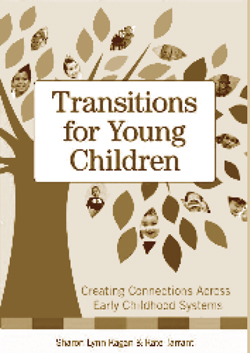Writing the Book on Early Childhood Transitions
Rethinking the structures that serve children, their families and their teachers
By Emily Rosenbaum
Young children need stability and continuity, as any parent will tell you. Unfortunately, those qualities have not defined early childhood education in the United States. At present, for young children moving from home to early education programs and from those programs to K-12 school, “transition” often consists of a one-time visit to the “big kids’” classroom and, if lucky, an accompanying transfer of school records.
Sharon Lynn Kagan, TC’s Virginia and Leonard Marx Professor of Professor of Early Childhood and Family Policy and Co-director of the National Center for Children and Families, has spent decades calling for a more coordinated early childhood system. In a new book, Transitions for Young Children: Creating Connections Across Early Childhood Systems (Brookes, 2010), co-edited with TC doctoral student Kate Tarrant, Kagan brings together her own ideas and that of many other policy experts from the United States and other nations.
In a combination of essays and case studies, Transitions advocates for a new, three-pronged approach to align educational goals as young children traverse the many programs and services they experience before ever setting a foot in schools. Pedagogical alignment focuses on the way students and teachers interact in the classroom; programmatic alignment focuses on services children and families experience (including everything from vaccinations to teacher-parent communications) as they move “between and among child-serving settings”; and policy alignment targets laws and regulations that govern or affect services to young children.
“Only by completely by rethinking transitions in a completely new way will they become reality,” Kagan says. “Rather than piecemeal projects, we must seek deeper transitions in the structures that serve youngsters, their families, and their teachers.”
Aimed at scholars, researchers, program professionals and advocates, Transitions argues for a new comprehensive and multi-faceted focus on supporting children, families, and early education settings as they seek to create continuous and quality experiences for young children.
The book provides guidance on transitions for infants and young children with disabilities; transition issues for ELLs; improving school readiness; supporting the quality and stability of the early childhood workforce; and improving accountability policies. Case studies include a mother-child program in Turkey, a Madrasa program in East Africa, alignment of teaching and curriculum in Red Bank, New Jersey, and a professional development initiative in New Mexico.
Transitions is unique in bringing the latest research to bear on policy, incorporating an international and national focus, and positing an entirely new approach to a problem that has thus far defied solution in early education. The book’s publication also follows on the heels of a new call by the U.S. Department of Education for increased attention both to early care and education and to transitions between early learning and public school settings.
In separate work funded by the Kellogg Foundation, Kagan and Tarrant, together with Romilla Karnati and Jocelyn Friedlander, have researched transition programs from around the world. The result is the National Center for Children & Families’ Compendium of Transition Initiatives in the Early Years, a database containing profiles of more than 80 of the best transition programs from around the world. The Compendium is searchable by several different variables, including program focus and characteristics of the children served.
Published Monday, Feb. 7, 2011

